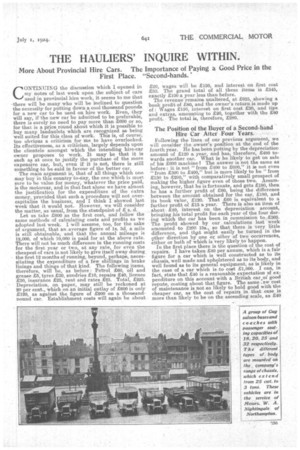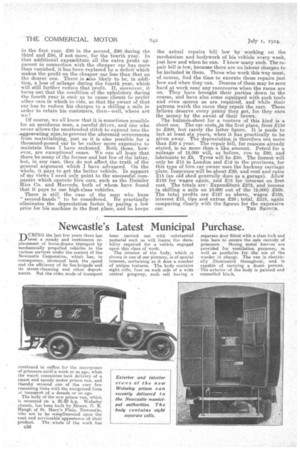THE HAULIERS' INQUIRE WITHIN.
Page 43

Page 44

If you've noticed an error in this article please click here to report it so we can fix it.
More About Provincial Hire Cars. The Importance of Paying a Good Price in the First Place. "Second-hands.'
CONTINUING the discussion which I opened in my notes of last week upon the subject of cars used in provincial hire work, it seems to me that .there will be many who will be inclined to question the necessity for putting down a cool thousand pounds for a new car to be used on hire work. Even, they will say, if -the-new car be admitted to be preferable, there is surely no need to pay more than 2600 or so, for that is a price round about which it is possible to buy many landaulets which are recognized as being well suited for this class of work. This is, of course, too obvious a criticism for me to have overlooked. Its effectiveness, as a criticism, largely depends upon the clientele amongst which the intending hire-car owner proposes to work. It may be that it is such as at once to justify the purchase of the more expensive car, but, even if it is not, there is still something to be said in favour of the better car. The main argument is, that of all things which one may buy in this country to-day, the one which is most sure to be value for money, whatever the price paid, is the motorcar, and in that fact alone we have almost the justification for the expenditure of the extra money, provided that such a procedure will not overcapitalize the business, and I think I showed last week that it would not. However, we will consider the matter, as usual, from the. standpoint of 2 s. d. Let us take 2600 as the first cost, and follow the same methods of calculating costs and profits as we adopted last week. I will assume, too, for the sake of argument, that an average figure of Is. 3d. a mile is still obtainable, and that the annual mileage is 12,000, of which 10,000 is paid for at the above rate. There will not be much difference in the running costs for the first year or two, at any rate, for even the cheapest of cars is not likely to give itself away during the first 12 months of running, beyond, perhaps, necessitating the expenditure of a few shillings in brake linings and things of that kind. The following items, therefore, will be, as before : Petrol 260, oil and grease 25, tyres 230, sundries 210, repairs 240, licence 230, insurance 225, rent and rates 225. Total, 2225. Depreciation, on paper, may still be reckoned at 20 per cent., which on an initial outlay of 2600 is only 2120, as against the figure of 2200 on a thousandnound car. Establishment costs will again be about 220, -wages will be 2150, and interest on first cost 230. The grand total of all these items is 2545, exactlY .2100 a year less than before. The revenue' remains unaltered, at 2625, showing a bookaarofit of 280, and the owner's return is made up of : Wages 2150, interest on first cost 230, and tips and extras, amounting to 220, together with the 280 profit. The total is, therefore, 2280.
The Position of the Buyer of a Second-hand Hire Car Alter Four Years.
.Following the lines of our previous argument, we will consider the owner's _position at the end of the fourth year. He has been putting by the depreciation amount of 2120 a year and has, therefore, 2480 towards another car. What is he likely to get on sale of his 2600 machine ? The answer is not the same as before : it is not "from 2400 to 2600," it is not even "from 2300 to 2400," but is more likely to be "from 2150 to 2200," with comparatively small prospect of making the higher figure even of those two. Assuming, however, that he is fortunate, and gets 2180, then he has a further profit of 260, being the difference between the amount obtained for the car, 2180, and its book value, 2120. That 260 is equivalent to a further profit of 215 a year. There is also an item of about 240, interest on the depreciation account, bringing his total profit for each year of the four during which the car has been in commission to2305. The profit showed by our calculations last week amounted to 2293 15s., so that there is very little difference, and that might easily be turned in the other direction by one oz other of two occurrences, either or both of which is very likely to happen. In the first place there is the question of the cost of repairs. I have taken 240 per annum, which is a. fair figure for a car which is well constructed as to its chassis, well made and upholstered as to its body, and well found as to its general equipment, as is likely in the case of a car which is to cost 21,000. I can, in fact, state that 240 is a reasonable expectation 'of expenditure on this account with a British car,a good repute, costing about that figure. The same .D.Vi cost of maintenance is not so likely to hold good with the cheaper car, as the cost of repairs in that case is more than likely to be on the ascending scale, as 240
in the first year, 250 in the second, £60 during the third and 280, if not more, for the fourth year. In that additional expenditure all the extra profit apparent in connection with the cheaper car has more than vanished, it has been replaced by a deficit which makes the profit on the cheaper car less than that on the dearer one. There is aho likely to be, in addition, a loss of mileage during the fourth year, which will still further reduce that profit. If, moreover, it turns out that the condition of the upholstery during the fourth year is such as to cause clients to prefer other ears in which to ride, so that the owner of that car has to reduce his charges to a shilling a mile in order to retain his customers, then—well, where are we ?
Of course, we all know that it is sometimes possible for an assiduous man, a careful driver, and one who never allows the unattended stitch to expand into the aggravating nine, to prevent the aforesaid occurrences from materializing, just as it is also possible for a thousand-pound car to be rather more expensive to maintain than I have reckoned. Both those, however, are exceptional cases. We can all hope that there be many of the former and but few of the latter, but, in any case, they do not affect the truth of the general argument which I have advanced. On the whole, it pays to get the better vehicle. In support of my views I need only point to the successful companies which operate hire cars, such as the Daimler Hire Co. and Harrods. both of whom have found that it pays to use high-class vehicles.
There is still the ease of the man who buys " second-hands " to be considered. He practically eliminates the depreciation factor by paying a low price for his machine in the first place, and he keeps the actual repairs bill low by working on the mechanism and bodywork of his vehicle every week, just how and when he can. I know many such. The repair bill is low, because there are no labour charges to be included in them. Those who work this way must, of course, find the time to execute those repairs just how and when they can. Dozens of them may be seen hard at work near any racecourse when the races are on. They have brought their parties down to the course, and have also come equipped with such tools and even spares as are required, and while their patrons watch the races they repair the cars. These fellows deserve every penny they get, for they earn the money by the sweat of their brows.
The balance-sheet for a venture of this kind is a short one. The car costs,,in the first place, from 2150 to 2200, but rarely the latter figure. It is made to last at least six years, when it has practically to be given away. The depreciation is therefore not more than £30 a year. The repair bill, for reasons already stated, is no more than a like amount. Petrol for a mileage of 12,000 will, as before, run to 260, and lubricants to 25. Tyres will be 230. The licence will only be .215 in London and £12 in the provinces, for this type of hire car owner uses the hackney carriage plate. 'Insurance will be about 220, and rent and rates 215 (an old shed generally does as a garage). Allow 2150 for wages again, and 218 for interest on first cost. The totals are : Expenditure 2373, and income (a shilling a mile on 10,000 out of the 12,000) 2500. The total profits are 2127 as above, wages 2150, interest 218, tips and extras £20; total, 2315, again comparing closely with the figures for the expensive car. THE SKOTCH.














































